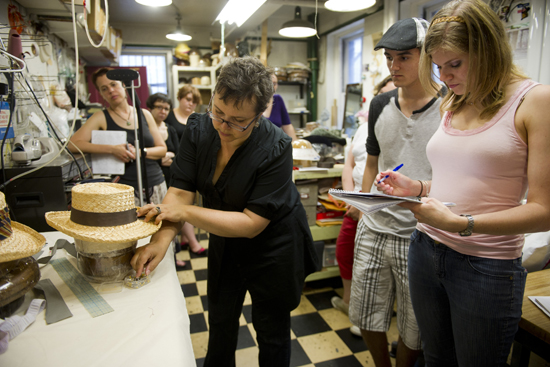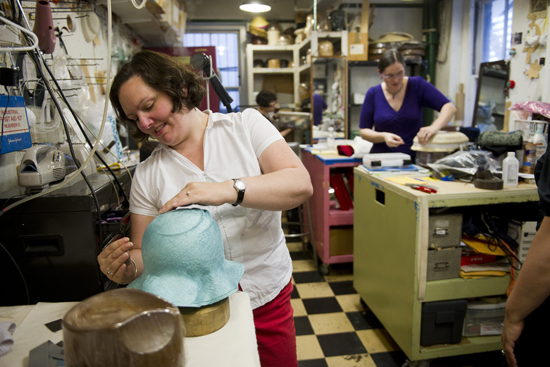Denise Wallace-Spriggs likes to tell her students that people stopped wearing fancy hats once the blow dryer came in, around the 1920s. Those who still do are likely to be royals, churchgoers, or actors.
Wallace-Spriggs (CFA’16) should know. As the Huntington Theatre Company’s resident craft artisan for the past 25 years, she’s an expert in the subject. In addition, she is a College of Fine Arts lecturer in costume crafts, teaching millinery, dyeing, and fabric modification to students in the theater program. She usually teaches millinery in a yearlong class, but this summer she covered the material in half a dozen six-hour sessions.
“It’s a sprint, not a marathon, to cover the whole year in six weeks,” Wallace-Spriggs said on a recent day while arranging class materials in the costume design shop down the hall from the BU Theatre’s main stage.
For the class’ first assignment, Wallace-Spriggs told the fledgling milliners—a group ranging from BU staffers, students, and Evergreen participants to Boston-area costume designers—to bring in a “found object hat” that “must stay on your head in some way and express a little something about you.” Students had to use something already in their possession. During the rest of the semester they learned to make hats using a different material each week: cloth, buckram, felt, straw, and wire.
“What I try to do is facilitate the making of the particular project they’re interested in,” she said. “Because each of the eight students is doing a different project, we get to learn eight kinds of things to do.”
On a sultry summer afternoon, students eager to learn about straw hats filled a narrow space that could best be described as organized chaos. Boxes of fabric lined the walls, countertops were covered with plastic cubbies holding buckles, buttons, and beads, and shelves were stacked with blocks used to shape a potentially endless array of hats.

Students watch as Wallace-Spriggs (center) fits a grosgrain hatband.
“The first thing we’re going to do is make some sizing,” Wallace-Spriggs said over the drone of a tired air-conditioning unit. She led students into an adjoining room, where she mixed a viscous slurry from gelatin and hot water, designed to make the straw more pliable. “It’s pretty nontoxic, except to any animal who gave up its cartilage tissues,” she said. She brushed the Jell-O-like “sizing” along the inside of a floppy straw hat and passed it around so students could feel how the stiff material had softened.
Back in the studio, she placed the hat over a steamer wand to absorb moisture before smoothing it over a wood block.
“I suppose you want to know what we’re going to make out of this,” she said.
“A hat,” piped up Ann Marie Shafer (COM’08, CFA’17), who is the evening circulation manager at Mugar Memorial Library. Sarcasm and creativity, in equal measure, are welcome in the class.
Wallace-Spriggs pointed to a plantation hat hanging from a rack at the front of the room. Plantation, or planter’s, hats are used onstage to connote a gentleman farmer, she said, and her goal that day was to replicate it. Every hat designed for the stage tells a story; hats help to establish the character, convey something about hierarchy and class, or reveal an occupation. Hats can also make for a flashy entrance. Being historically accurate to a play’s period is critical. The right hat “helps to establish the fullness of the silhouette of that period,” she said. “The wrong hat can put it someplace else.”
While Wallace-Spriggs steamed, measured, sewed, and cut her straw hat into shape, she discussed the benefits of various types of straw (from cotton and cellophane to raffia and paglina), the best places to buy supplies, and how to “have no fear” when sewing straw on a machine. She quizzed her students throughout the process and teased them about how bored they must be watching her work. That was hardly the case, as they crowded around, snapping pictures, taking notes, recording her every move. Finally, she attached a grosgrain band to the inside of her planter’s hat so that, should the straw stretch, it would retain its shape.
And with that, “you have a hat,” she said, holding up her work.

Liz Fitzpatrick (left) molds waves into her straw hat, while Ann Marie Shafer (COM’08, CFA’17) fits her hat around a rim block.
But her students wanted to know more. They asked her how to make a “masculine” fedora bow, how to measure enough material for a braid hat using as little math as possible, and how to create a decorative band like the one on her plantation hat. Wallace-Spriggs provided the answers with quick demonstrations and urged students to “take apart hats. There are little secret things” inside, like hidden masking tape binding fabric together.
Students then dispersed to work on their own straw hats, with their teacher offering advice and guidance. While Shafer smoothed a floppy hat over a wooden block, Juliana Gregori, a costumer for a local theater, spread sizing inside her navy blue hat. A third student, Liz Fitzpatrick, pinched waves along one side of her aqua hat. Students passing by praised the look.
Laughing, Fitzpatrick said, “I’m afraid I’m going to do too much, because I’m enjoying it too much.”
Wallace-Spriggs can sympathize. She made her first hat (a galley cap for her golfer father) when she was a little girl and got hooked. “I always liked making stuff,” she said. That passion turned her into an artisan and a teacher, as well as an entrepreneur: she designs and sells hats through her business Winged Heart Millinery. “The nature of most theatrical craftspeople is to take things apart, figure out how they were made, and make your own,” she said. “It’s kind of our nature, and it’s my nature. I want to make things and then give them away.”
Judging by the quality of her work, Wallace-Spriggs has many happy friends.















































Related Stories
Huntington Theatre Company to Remain at Present Location
Mayor announces agreement between developers and company
A Plum Role for CFA Alum in Huntington’s Tartuffe
Award-winning actor brings wit and intelligence to Moliére’s Madame Pernelle
Hat Tricks
Sending messages of thanks, inspiration, commitment—via mortarboard
Post Your Comment